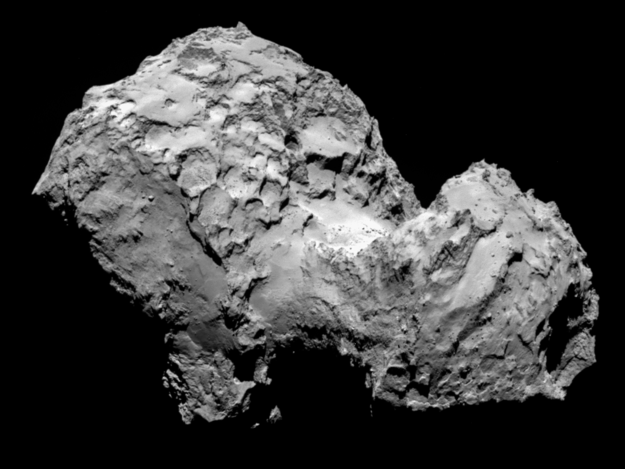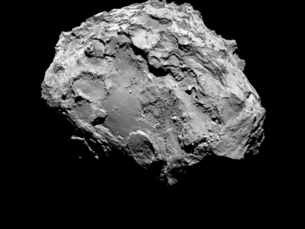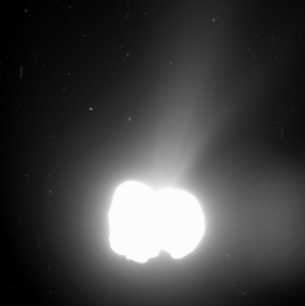After a 10 year-long journey chasing its target, Rosetta has today become the first spacecraft to rendezvous with a comet, opening a new chapter in Solar System exploration. Here’s how the view must have been:

Comet on 3 August 2014 – front. Credits: ESA/Rosetta/MPS for OSIRIS Team MPS/UPD/LAM/IAA/SSO/INTA/UPM/DASP/IDA
The image shows Comet 67P/Churyumov-Gerasimenko by Rosetta’s OSIRIS narrow-angle camera on 3 August from a distance of 285 km. The image resolution is 5.3 metres/pixel. The image was exposed for 1.6 seconds. It is unprocessed, just brightness scaled.
Here’s another image, showing the “other” side of the comet. The two images are separated by about 4 hours (120 degree comet rotation).

Comet on 3 August 2014 – back. Credits: ESA/Rosetta/MPS for OSIRIS Team MPS/UPD/LAM/IAA/SSO/INTA/UPM/DASP/IDA
And if you’re wondering about the comet’s activity, here’s another recent image that shows the surroundings of 67P/C-G’s nucleus:

Comet activity on 2 August 2014. Credits: ESA/Rosetta/MPS for OSIRIS Team MPS/UPD/LAM/IAA/SSO/INTA/UPM/DASP/IDA
It was taken by Rosetta’s OSIRIS wide-angle camera on 2 August 2014, from a distance of 550 km. An oxygen-I gas filter with a central wavelength of 631.6 nm was used. This narrowband filter has 4 nm bandwidth.
Read more about Rosetta’s rendezvous with the comet here.









Discussion: 15 comments
Super!!
Mind blowing! Thank you guys!
Amazing !
Here’s the result of a wonderful cooperation between Europe countries.
This is an extraordinary achievements in Space Technology and will be making us to know the more details of the Comet in this part of the universe. but the question is that how long Rosetta will be able to keep himself in orbit of this comet?
Fantastique!!!!!
Ça c’est vraiment quelque chose de génial!!
Splendid !
Congratulations to Rosetta’s team for the perfect job done during the last two decades.
I visited the blog daily during the last 2 weeks and the approach of the nucleus, discovering more and more details was just a fantastic journey.
Thanks to the team for sharing so much, no doubt that Rosetta and Philae will offer us many other gifts during the next weeks.
Breathtaking ! And much, much more to come! Thank you guys for this achievement.
Excellent effort ESA
Congratulations ESA! Mind blowing pictures of this Comet! cant wait untill todays pictures arrive of this peculiar comet. Will be difficult to pick a landing site for Philea in October. Lot of craters! so near to each other, but not within the craters themself!? Good luck futher on.
Will the spacecraft have an effect on the comets flight path?
Congratulations to the team for this magnificent success!
Magnificent!
Congratulations and keep on with your excelent work
It’s really a great achievement for all those working for this to happen. Congratulation. Now let’s see what happens next. Beautiful minds!
Unfortunately, the spacecraft will modify the trajectory of the comet just enough for it to deteriorate in the sun’s corona.